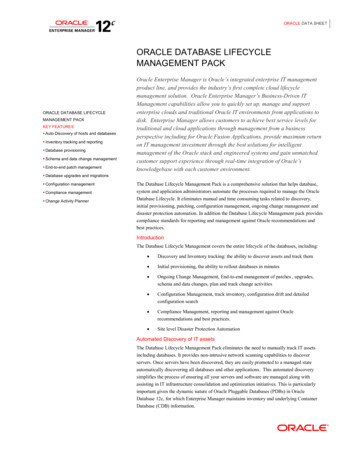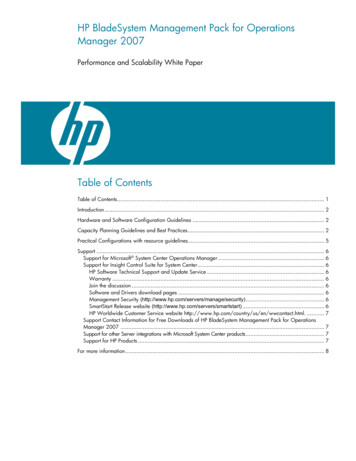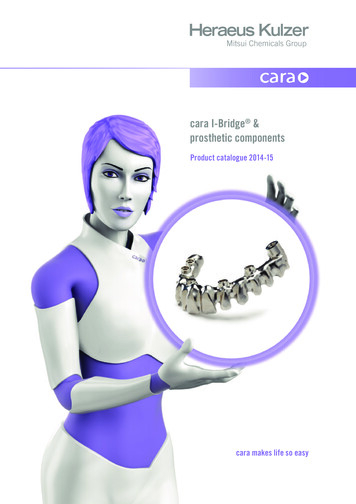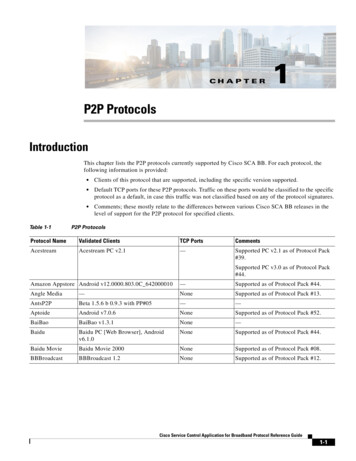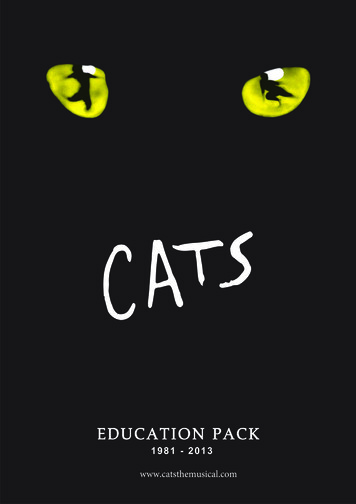
Transcription
EDUCATION PACK1981 - 2013www.catsthemusical.com
WELCOMECATS is a unique and inspirational musical; a blend ofAndrew Lloyd Webber’s music, T S Eliot’s poems andthe creative talents of Trevor Nunn, Gillian Lynne andJohn Napier. CATS first appeared on the London stagein 1981 and went on to become the longest runningmusical both in the West End and on Broadway.The cats gather together for the Jellicle Ball, and oneby one tell their stories for the entertainment of OldDeuteronomy. Despite interruption from Macavity, themystery cat, the cats end their celebration with thejourney of one of their number to the Heavyside Layer.The magic of CATS makes it an ideal inspiration forclassroom activity. This pack offers a range ofactivities to introduce your pupils to the story andcharacters of CATS before seeing the show, plus indepth background information, follow up activity ideasand useful resources. The Pack is generally aimed atpupils from Key Stage Two and Three, but can beadapted for any age or ability. The Pack is fullyphotocopiable for classroom use.The CATS Education Resource Pack was written bySu Newell, Head of Education & Outreach at theLiverpool Empire Theatre. With thanks to Keith Kenny,Tony Pinhorn, Sally Bayes and the cast and companyof CATS.www.catsthemusical.comContentsIntroduction to CATS02Synopsis03Introduction Activities05Background to CATSnnnnnnnTS Eliot – his life and writingsContextThe Creative TeamThe DesignCreating a CatCATS FactsReviews of CATS08090911121414Follow up Activities16Resources20Appendix211
INTRODUCTION TO CATSOld Possum’s Book of Practical Cats – on which themusical CATS is based – was written by T S Eliotduring the 1930’s and first published in 1939 by Faberand Faber. Although Eliot generally intended his catpoems to be for children, they were also appealing andamusing to adults.With a little adaptation Andrew Lloyd Webber usedEliot’s poems as lyrics and set them to music to createthe musical CATS. The inclusion of elements ofRhapsody on a Windy Night and some of Eliot’sunpublished writings enabled the character ofGrizabella the glamour cat to be used and so astoryline emerged that formed a shape for the poemsand a basis for a musical.A set was designed by John Napier – to cat scale –creating a place where the cats could congregate forthe Jellicle Ball and dance pieces were choreographedby Gillian Lynne to enable the performers to move andexpress themselves as cats.CATS first opened in May 1981 at the New LondonTheatre and went on to become a huge successthroughout the world, influencing not only futuremusical theatre but also the development of futureperformers and creators of musicals.Over sixty years after Eliot wrote his poems and twentyyears after CATS first appeared as a musical the storyand characters still hold immense appeal for audiencesof any age or background. CATS takes you into aworld of fascinating creatures, with stories to tell andjourneys to take, expressed through music, song anddance.www.catsthemusical.com2
SYNOPSISMidnight. Not a sound from the pavement. Suddenlyan explosion of music and lights reveals a larger-thanlife junkyard. Probing car lights tear across thedarkened landscape of bottles and boxes, brieflycatching the darting image of a running cat. Tonight isthe one special night each year when the tribe ofJellicle Cats reunites to celebrate who they are.They emerge singing of their unique abilities andspecial traits. The cats are at first suspicious andreluctant to allow the audience into their domain. Theyare proud, however, and in The Naming of Cats explainto their human visitors who they are and reveal thatcats have three different names: the one the familyuses daily, a more dignified name and, finally, a secretname. It is the contemplation of these secret namesthat keeps cats deep in thought.old leader Old Deuteronomy arrives. The cats adoreand respect him. ‘And now that the Jellicle leader ishere, Jellicle Cats can all rejoice!’They entertain him with a special show thatMunkustrap narrates, The Awefull Battle of the Pekesand the Pollicles together with The Marching Song ofthe Pollicle Dogs. The cats dress up as the two rivaldog factions who bark ceaselessly at each other untilthey are frightened away by the great Rumpus Cat, asleek and powerful feline.Yet another crash from the villainous Macavity is heard,which sends the cats scurrying. Old Deuteronomysoothes them as they come back one by one. It is timefor The Jellicle Ball, the great annual dance in which allof the cats celebrate.Victoria, a young white cat, dances to signal TheInvitation to the Jellicle Ball. Munkustrap, a large greytabby, explains that the Jellicle Cats meet once a yearto rejoice! They are waiting for their leader, the wiseOld Deuteronomy, who will choose which one of theJellicle Cats will journey to the Heavyside Layer to be‘reborn’ into a new life!Grizabella appears once more, wanting to rejoin herfamily and be a part of the celebration. She is left tocontemplate her Memory of the time before she left thetribe. She stretches out her hand behind her, hopinganother cat will touch her. She is still not accepted and,disappointed, slinks off into the night.Jennyanydots, The Old Gumbie Cat, sleeps andlounges all day long. ‘She sits and sits and sits andsits, and that’s what makes a Gumbie Cat!’The Rum Tum Tugger is a contrary character that thefemale cats find extremely attractive, and who enjoysbeing the centre of attention.Grizabella, the glamour cat, is shunned by the rest ofthe tribe despite being a Jellicle Cat. She left the tribeyears ago to explore the outside world and now wantsto return.Bustopher Jones is a large ‘twenty-five pounder’,always clad in his signature white spats. He spendshis time eating and eating in one of the many Englishpubs and clubs that he frequents.IntervalSuddenly a thunderous crash, followed by the sound ofpolice sirens and flashing red lights signals that thevillainous cat Macavity is on the loose! The catsscatter, leaving an empty stage.Two off-stage giggles signal the entrance ofMungojerrie and Rumpelteazer, a fun loving, frolickingteam of pranksters who are always getting in troublewith the family with whom they live.The entire tribe re-enters as their benevolent and wisewww.catsthemusical.comAfter the Jellicle Ball, the cats rest and contemplateThe Moments of Happiness before introducing morecats. Gus the Theatre Cat is an aged stage actor whoworked with the greatest actors of his day. Gus tells ofhis greatest theatrical triumphs, and yearns to performagain.Skimbleshanks the Railway Cat introduces himself. Afriendly uncle to all of the cats, Skimbleshanks attendsthe trains he rides, and makes sure every detail isperfect.A third crash interrupts the celebration, and this timethe villainous Macavity appears. Two of his henchmeninvade the proceedings and kidnap Old Deuteronomy.Demeter and Bombalurina sing of what they know ofMacavity, whose evil deeds have resulted in his beingdubbed ‘the Napoleon of crime’.Macavity returns, disguised as Old Deuteronomy, buthe is exposed and battles with Munkustrap and theother male cats. Tired and almost defeated, Macavityrigs an electrical explosion that puts out all the lights,leaving the Jellicles in the dark.3
But they still have to find Old Deuteronomy. The RumTum Tugger calls in Mr Mistoffelees, the conjuring cat,to use his magical powers to bring back their leader.Mistoffelees succeeds in reinstating the lights, locatingOld Deuteronomy and showing off his magic tricks,including his infamous conjuring turn.At last the time has come for Old Deuteronomy tomake the Jellicle Choice and decide which cat will bereborn into a new Jellicle life. At that moment,www.catsthemusical.comGrizabella reappears. Again she recalls her Memory ofhow things used to be. This time the cats accept herback into the tribe and it is she who is chosen toJourney to the Heavyside Layer and be reborn.The Jellicle Ball has come to a conclusion, but first OldDeuteronomy instructs the human spectators in TheAddressing of Cats. For all of their unique qualities anddifferences, he says, ‘cats are very much like you’.4
INTRODUCTION ACTIVITIESBefore taking your class to see CATS there are anumber of Introduction Activities you can work throughto introduce them to the story and characters, givethem an understanding of Eliot’s poems and also toallow them to discuss their ideas and expectationsabout the musical.It is suggested that you select from the activities belowthose most suitable to the age and ability of yourpupils. If you are working to a limited timescale thenthe activity introducing and exploring the story is mostimportant – some of the other activities can be returnedto after you have seen the show.If possible you should try and see the show beforeembarking on these activities with your class (or atleast watch the video or listen to some of the music onCD), so you have a clear idea of the story and contentof the show and are able to tackle some of thequestions your pupils may ask. This pack will alsoprovide you with some of the answers.Below is a list of suggested resources you may finduseful when undertaking the Introduction Activities.Suggested ResourcesOld Possum’s Book of Practical CatsCD recording of CATSPoster and/or leaflet for CATSVideo or DVD of CATS(Full details of these resources can be found on page 27)Introduction Activities1.2.3.4.Introducing the story and characters and CATSExploring Eliot’s poemsCreating a CATS environmentDiscussing CATS in the theatrewww.catsthemusical.com1. Introducing the story andcharacters and CATSOld Possum’s Book of Practical Cats does not tell asingle story, but the stories of many of the Jellicle Cats– each poem standing alone as an individual story.When creating the musical Andrew Lloyd Webber andTrevor Nunn felt it needed a narrative thrust, a way oflinking the poems together so that the audience couldfully engage with the characters and understand theenvironment they live in. A combination of the idea ofthe Jellicle Ball and the story of Grizabella (from anunpublished poem) and a fragment of an idea fromEliot about the Heavyside Layer came together to formthe narrative thread Andrew Lloyd Webber and TrevorNunn were looking for – that the cats gather togetheronce a year for the Jellicle Ball, a chance to sharestories and entertain one another, with the addedinducement that one fortunate cat will be chosen totravel on to the Heavyside Layer. The audience havebeen ‘allowed’ in to witness this magical and secretceremony in order that they will come to more fullyunderstand the nature of cats.It is a good idea to introduce your pupils to this beforethey see the show, to enable them to recogniseelements of the story – and certain characters – sothey can more fully enjoy and appreciate theperformance, and also take more away from theexperience that they can develop through the FollowUp Activities.To introduce the story discuss with your pupils any catsthey own as pets – what are their names, whatpersonalities do they have, what do they imagine theyget up to when they are out of sight? Introduce thecharacter of Munkustrap to the class (see the CATSCharacter guide in the Appendix) and tell the story ofthe musical as if it were told by him (see Appendix foran example). Once the story is told have a discussion,raising any issues your pupils may not haveunderstood, explaining Eliot’s vivid imagination and,also, the historical context (Eliot was writing in the1930’s).Keep a copy of Munkustrap’s story on display in theclassroom, at this point you may wish to ask your classto choose a character (see the CATS Character guidein the Appendix) and either write a short descriptivepiece, illustrate their chosen character or write a shortstory about them before you do any in-depth work onthe poems themselves.5
Read and display your class’ work and tell the story ofthe musical again at least once before your trip to thetheatre to see the show.to behave. After a short time share and discuss theimprovisations – how do the depictions ofJennyanydots differ? Read the poem again and decidewhich is the most accurate.2. Exploring Eliot’s poemsn Macavity: the mystery catRead the poem aloud and discuss any unfamiliarlanguage.As a class make a spider diagram of words andphrases on the board or a large sheet of paper thatdescribe Macavity. What do your pupils think aboutMacavity – is he an exciting character or do theydisapprove of him?Make a second spider diagram of words and phrasesto describe the character of a detective cat who couldtrack Macavity down and capture him. Think of a namefor the detective cat.Using the spider diagram for ideas ask your class toeach write a short story about the detective cat whohunts for Macavity. Use information from the poemabout Macavity’s crimes, and explain how, eventually,Macavity is caught.Read some of the completed stories aloud and displaythem all with the poem.It is important to introduce your pupils to some of Eliot’spoems before seeing CATS as it will give them anopportunity to explore the stories, language, rhythmsand structure of the poems leading to a familiarity withthe songs and characters when they see the show.Four poems have been selected, with linked activitiesfor each one, but you can choose which poems youfeel most suitable for your pupils to study and adapt theactivities accordingly. Each activity begins with readingthe poem and discussing the content, any languageyour pupils are not familiar with (Eliot often made up hisown words to use in his poems!) and the charactersdescribed.n The Naming of CatsRead the poem aloud and discuss any unfamiliarlanguage.The poem explains each cat has three names – theone used by their human owner, one of their ownchoosing and one secret name that no one everknows.Discuss with the class why names are so important, isthere anyone who would change their name – to whatand why? – do they think it is a good idea to have threenames, especially if they can choose one of themthemselves?Ask them to work in pairs and choose one of the catnames from the poem, for example Alonzo, and write ashort description together of the cat’s appearance andcharacter suggested by the name.Read some of the descriptions aloud and display themall with the poem.n The Old Gumbie CatRead the poem aloud and discuss any unfamiliarlanguage.Ask your class to describe the two different sides toJennyanydot’s character – by day and by night.Working in groups of five or six ask your class toimprovise scenes depicting Jennyanydot’s night timeactivities with the mice and cockroaches, or any othercreatures they think she might discipline, like spiders orwoodlice. They should think about Jennyanydot’scharacter and how she gets the mice and cockroacheswww.catsthemusical.comn Gus: the theatre catRead the poem aloud and discuss any unfamiliarlanguage.Discuss the types of roles Gus has played in thetheatre, the performances he has seen or been in –and others he may have, such as Puss in Boots – withyour class, remembering that Gus is a cat fromVictorian times. Talk about the differences in theatre ahundred years ago, for example in the sets andlighting.Gus’ favourite character that he ever played – and hisgreatest triumph – was Fiorefrorefiddle, the Fiend ofthe Fell. Ask your class to imagine who or what thatcharacter was and do an illustration of Gus asFirefrorefiddle to accompany the poem.Display the illustrations with the poem.6
3. Creating a CATS environmentTo encourage your class to think about cats and theirmany different ways and habits, create a CATSEnvironment in your classroom.Collect together pictures of and books about cats tostart a display and ask your pupils to bring in photos oftheir own cats and any newspaper or magazine storiesor articles they may find.There are many other cats in fiction (such as SixDinner Sid, Orlando the Marmalade Cat, Gobbolino theWitches Cat, etc). Your pupils may enjoy searching thelibrary for other stories and poems about cats, whichcan be added to the display and may be useful for yourfollow up work.Any work that your pupils produce whilst you areworking on CATS (especially from the previous activity)can also be added to the display. You can obtainposters and leaflets for the show from your theatre toput on your display.4. Discussing CATS in the theatreBefore you see the show you may wish to discuss thevisit to the theatre with your class.Discuss - What they expect to see.How they think the performers may bedressed or made-up.What they think they might hear.You can look at posters and leaflets advertising theshow and listen to one or two of the songs on the CD(perhaps choosing the ones from Activity 2: ExploringEliot’s Poems). Is the music the same or different fromwhat they expected?Ask your pupils to write down their thoughts andfeelings about CATS before they see the show, eitheras a collection of words, a letter to a friend or even apoem! You can then return to these after your trip tothe theatre and discuss how their expectations wereright or wrong.www.catsthemusical.com7
BACKGROUND TO CATSTS Eliot – his life and writingsThomas Stearns Eliot is widely regarded as one of ourgreatest writers, whilst mostly noted for his poetry, healso wrote verse plays and a range of literary andsocial criticism. He received many honours anddistinctions for his writing, including the Nobel Prize forLiterature and a posthumous Tony Award for CATS(1983).Eliot had a lifelong affection for cats, often sendingletters and poems about his own cat to his godson,Tom Faber and making up unusual or outlandishnames for cats for friends – and complete strangers!Practical Cats was originally going to include poemsabout consequential dogs as well and ‘Mr Eliot’s Bookof Pollicle Dogs and Jellicle Cats’ was advertised inFaber & Faber’s 1936 Spring catalogue. Eliot felt,however, that it would be “impolite to wrap cats up withdogs” and the book became only about cats. Thereason the book was eventually titled Old Possum’sBook of Practical Cats, is that Possum was Eliot’s aliasamongst his friends.Most of the poems were written between 1936 and1938. Many of the cats were modelled on other literaryfigures (Macavity is styled on Moriarty, the infamousvillain who challenged Sherlock Holmes andSkimbleshanks on a work by Rudyard Kipling – TheLong Trail) and some poems Eliot wrote with music inmind (The Marching Song of the Pollicle Dogs waswritten to the tune of ‘The Elliots of Minto’). Grizabella,the glamour cat remained incomplete and unpublishedas Eliot felt it was becoming too sad for his intendedyouthful audience.Timeline1888T S Eliot born in Saint Louis, Missouri, US1906-1909 Undergraduate at Harvard University1909-1910 Post-graduate studies at Harvard. Early writing,including the beginning of Prufrock1910-1911 Studied at the Sorbonne in Paris and inGermany. Completed Prufrock1911-1914 Returned to study at Harvard1914-1915 Further study in Germany interrupted by theFirst World War. Continued studying at MertonCollege, Oxford. Prufrock (verse) published inChicago1915Married to Vivien Haugh-Wood1915-1920 Settled in England and taught in two schoolsbefore working for Lloyds Bank and as a magazineassistant editor. Eliot continued to write whilstworking for the bank. In 1917 The Love Song ofAlfred J Prufrock (verse) was published in London.1921-1922 Worked as a correspondent for ‘The Dial’.Founded ‘The Criterion’, which he edited until 19391922The Wasteland (verse) published, his most famouswork.1927Confirmed in the Church of England and became anaturalised British Citizen1930Ash Wednesday (verse) published1932Selected Essays (literary criticism) published1935Verse play Murder in the Cathedral commissionedfor the Canterbury FestivalOld Possum’s Book of Practical Cats was firstpublished in October 1939, with illustrations by Eliothimself on the cover, at 3 shillings and sixpence a copy.Today they are recognised as classics, and have beentranslated into many other languages. Macavity, themystery cat was selected as number 66 in a BBC pollof the Nation’s favourite poem in 1995, and thepopularity of the musical CATS has sustained theworldwide interest in the original poems.1939The Family Reunion (play), Old Possum’s Book ofPractical Cats (verse) and The Idea of a ChristianSociety (social criticism) published1943The Four Quartets (verse), generally regarded ashis masterpiece, first published as a single work1947Death of Vivien, Eliot’s wife after a long illness1948On the right is a timeline of T S Eliot’s life, featuring keyevents and his most important writings.Received the Order of Merit – bestowed by KingGeorge VI. Awarded the Nobel Prize for Literature1957www.catsthemusical.comMarried Valerie Fletcher1958The Elder Statesman (play) published1965January – Eliot died in London. There is amemorial to him in Poet’s Corner, WestminsterAbbey.8
CONTEXTTHE CREATIVE TEAMIn order to help understand some of the complexitiesthat surround the musical CATS it is useful to explorethe context and timescale of the journey from T SEliot’s poetry to the London stage.CATS was the idea of Andrew Lloyd Webber, whocomposed the music to T S Eliot’s poems. Once he hadbegun to create the show Andrew Lloyd Webbergathered a number of other people together to work onCATS, including Trevor Nunn and Gillian Lynne.T S Eliot was born in America in 1888 but became aBritish citizen in 1927 after twelve years of living in theUnited Kingdom. His writing would have beeninfluenced by the different cultures he grew up with, thelong years he spent studying at different universitiesand the political and social changes he experienced,including the First World War.Eliot wrote Old Possum’s Book of Practical Cats duringthe late 1930’s and it was published in October 1939,just after the outbreak of the Second World War.Eliot was writing of cats during a time when cats wereowned to be useful – to keep down mice – as much aspets. A time when a different class system existed andwhen the pace of life was very different to the early21st Century. His cat poems were mainly set inLondon, but one that we would not recognise, aLondon of theatre, gentlemen’s clubs and publichouses, telling of a bygone age with nostalgia andfondness. Gus the theatre cat mentions Henry Irving,a great actor in the Victorian era, Skimbleshankstravels on steam trains and Mungojerrie andRumpelteaser live in a house with a cook and otherservants to attend to their owners.Andrew Lloyd Webber was born in 1948 and enjoyedreading Eliot’s cat poems as a child. He began writingCATS in the late 1970’s, after the success of Josephand the Amazing Technicolor Dreamcoat, Jesus ChristSuperstar and Evita, on which he collaborated with TimRice. CATS opened in 1981, forty-two years after thepoems were published and was a close collaborationwith Trevor Nunn and Gillian Lynne, who hadpreviously worked together at the Royal ShakespeareCompany. All these different people, with their differentbackgrounds in the arts and various ideas had aninfluence when creating the show.The current tour of CATS (2003/4) brings both thepoetry and the musical to new audiences, over half acentury since the poems were written and twenty-twoyears since the musical was first produced. Onceagain the attitudes and viewpoints of audiences haschanged and it is the nature of the enduring quality andcharm of both the poems and the musical that they stillremain so popular today.www.catsthemusical.comAndrew Lloyd WebberAndrew Lloyd Webber has writtensome of the world’s best-knownmusicals in the world, includingJesus Christ Superstar, Evita andSunset Boulevard. He has alsocomposed film scores and a settingfor a Latin Requiem Mass. He haswon numerous awards for his work– from Tonys, Grammys andLaurence Olivier Awards to an Oscar and a GoldenGlobe. In 1982 he became the first person to havethree musicals running simultaneously in the West Endand on Broadway. In 1992 he was knighted and in1996 received the Richard Rodgers Award forExcellence in Musical Theatre. In 1997 he waselevated to the peerage as Lord Lloyd Webber ofSydmonton.Late in 1977 Andrew Lloyd Webber began setting thepoems from T S Eliot’s Old Possum’s Book of PracticalCats to music. He knew the poems well from hischildhood and wanted to attempt writing music to lyricsalready set, rather than the other way around, whichwas his normal practise. Initially the idea was as muchfor his own interest as for public performance, althoughhe did feel that it may form the basis for a concertpiece. In 1980 some of the songs he had set to musicwere performed at his annual Sydmonton Festival.They were seen by Valerie Eliot, T S Eliot’s widow, whogenerously gave access to many of his unpublishedwritings and enabled the creation of CATS to move onto a different level.Creating a musical is a collaborative process andAndrew Lloyd Webber knew he had to have the rightteam working with him to make CATS work. He initiallyapproached producer Cameron Mackintosh with theidea that CATS could form a double bill with Variationsbut it was soon decided that it should form a completemusical on its own. It was vital to find the right directorand choreographer to work with Andrew Lloyd Webberand Trevor Nunn was approached as director, followedby choreographer Gillian Lynne who had collaboratedwith Trevor Nunn (at the RSC) and CameronMackintosh before.9
Trevor NunnTrevor Nunn was Artistic Director of the RSC foreighteen years and his work there included a greatnumber of Shakespeare plays, alongside RestorationComedy and new writing. With his colleague JohnCaird, he co-directed Nicholas Nickleby and LesMiserables. He has also directed Starlight Express,Aspects of Love and Sunset Boulevard for AndrewLloyd Webber and a number of operas forGlyndebourne and the Royal Opera house. He spentseveral years as Director of the Royal NationalTheatre, has directed many television productions andthree films.Trevor Nunn was intrigued by the premise of CATS butfelt that some sort of narrative was vital to making thepiece work. When Valerie Eliot sent the fragment ofEliot’s poem Grizabella, the glamour cat to AndrewLloyd Webber, Trevor Nunn felt it was the key to thewhole piece and could be used to form a story that theother poems and dance would fit in to. He workedalongside Andrew Lloyd Webber creating the musicaland even contributed lyrics – in the structure of thesong ‘Memory’. CATS was difficult to cast. At thebeginning there was no script and few of the catcharacters had names. Trevor Nunn knew Judi Denchfrom his work with the RSC and she expressed aninterest – asking if there was a sleepy old cat that shecould play. She was cast as the Old Gumbie Cat, andalso as Grizabella, and gradually the rest of the castcame together, including Paul Nicholas as the RumTum Tugger. Initially rehearsals were spent working onthe dancing and also improvisation and characterdevelopment. Several days into rehearsals, after alunch time spent in the pub, Trevor Nunn was able tocome up with sixteen cat names (all from the poems)and allocate them to the different performers based onthe improvisation work they had done, and so enableeach cat to have a character and begin to tell theirindividual story.Gillian LynneGillian Lynne has been involved in over fifty West Endand Broadway shows as either director orchoreographer, as well as working extensively in filmand television.She was instrumental in thedevelopment of Jazz Dance in Great Britain and isrecognised world-wide for her groundbreakingchoreographic style.Gillian Lynne was asked to go and see Andrew LloydWebber regarding a new project based on Oldwww.catsthemusical.comPossum’s book of Practical Cats. She had never readthe poems, so quickly bought a copy to read on thetrain on her way to the meeting. He played her someof the music he had composed and she was instantlyvery excited by it and became involved in the creativeprocess. She worked with a small team (danceassistant, dance captain and one boy and one girldancer) and put together ideas for movement andchoreography for three quarters of the show, whichwas then presented to Andrew Lloyd Webber andTrevor Nunn.She observed her own cats indeveloping the dances, often creating completely newsteps and movements and helped Andrew LloydWebber develop some of the music, especially for theJellicle Ball, as he had never written music purely fordance before. Once rehearsals began, she workedwith the cast, alongside Trevor Nunn developing thepiece and making sure all the dancers were of thesame standard, fit and flexible enough to cope with ashow that demanded two and a half hours ofexhausting dancing. There were only five weeksavailable for rehearsal and when they began therewere still some songs incomplete and constantchanges to the music.Many characters weredeveloped through the way that they moved, withconstant reference back to the poems.As rehearsals progressed the show began to cometogether more. It was a challenging time for everyone– a show like this had never been seen before andthere was great scepticism about whether it would work– even to the extent that the New London Theatre,chosen as the venue, had to be persuaded not to pullout at the last moment. Then disaster struck when JudiDench snapped her Achilles tendon during rehearsalsand had to go into hospital. An anxious wait to see ifshe would recover in time ensued, but when shereturned to rehearsals she fell off the stage and injuredherself again and it was obvious she would have to bereplaced. Elaine Paige, who had starred in Evita,agreed to save the day and, with minimal rehearsal,was ready for the first preview, even though the songshe has become famous for – ‘Memory’ – wasn’t.The show continued to be changed and developedthroughout the previews but was receiving a favourableresponse from the audiences. On opening night CATSwas well received by the critics and soon queuesbegan to form at the box office. Broadway producers
Eliot's poems as lyrics and set them to music to create the musical CATS. The inclusion of elements of Rhapsody on a Windy Night and some of Eliot's unpublished writings enabled the character of Grizabella the glamour cat to be used and so a storyline emerged that formed a shape for the poems and abasis for a musical.
